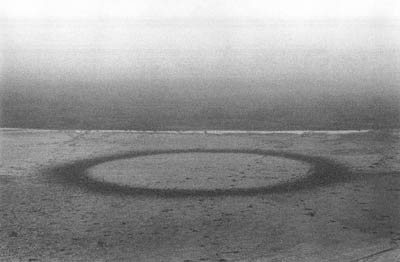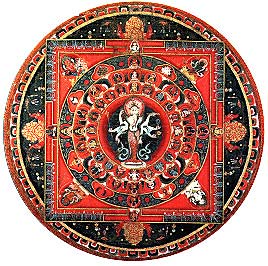Richard Long & Circles
I’ve been doing further research into artists who have incorporated the use of the journey into their artistic practise to inform my own methodologies.
“Art as a formal and holistic description of the real space and experience of landscape and its most elemental materials.”
The work of British born artist Richard Long involves the exploration of the landscape on foot as a means of re-engaging with the natural environment and investigating the ‘relationships between time, distance, geography and measurement.’ He often makes interventions in the landscape during his walks which he calls ‘landscape sculptures’. These are often constructed from natural materials such as stones and grass which he may collect enroute to his final destination. This idea of ‘walking as art’ is presented in three ways: in photographs, maps or text, each of which functions as a ‘distillation of experience’.
Sometimes he embarks on very precise routes that have a straight or even circular trajectory, which then feeds directly into the sculptural works that he creates. Long views his landscape sculptures as occupying the space between two opposing ideologies, namely that of ‘making monuments’ and ‘leaving only footprints.’
Where my work finds common ground with Long’s is in the compositional use of materials gathered whilst journeying through an environment. In his work he uses or intervenes with the physical, material elements from a natural landscape to create his sculptures, whilst my work, in contrast, predominantly uses sound, the immaterial element collected from urban environment. However, there is a gap in the way in which the digital artist approaches the composition of ‘natural’ material gathered from environments. Whilst land artists, such as Long, have the ability to compose directly in the location their work is addressing, I will always have to return home to work on material. Perhaps reflecting on material during my journeys will fill this compositional void.
A strange parallel also begins to form between our individual works within the use of the circle. With my Window Music piece, my use of a cyclic structure was to reflect the endlessness of the soundscape, how one is enveloped within the sounds that inhabit a particular place until one decides to leave. For me, this feeling of being enveloped within sound, whether it be a piece of composed music or the soundscape, is a feeling I can only describe as completeness. I feel like sound is the one thing that grounds my experience of the world and without it I simply wouldn’t exist; it completes the circle of my being.
But why is the circle such a powerful symbol? I must find that Jung book!
“Dr. M.-L. von Franz has explained the circle (or sphere) as a symbol of the Self. It expresses the totality of the psyche in all its aspects, including the relationship between man and the whole of nature. Whether the symbol of the circle appears in primitive sun worship or modern religion, myths or dreams, in the mandalas drawn by Tibetan monks…. it always points to the single most vital aspect of life – its ultimate wholeness.” (Jung. 1964: 240)
For Long perhaps, there is a similar yearning for tapping deeper into the Self: ‘It is as if Long is looking to regain some insight into those lost recesses of primordial consciousness as suggested by his ritualized circles and spirals.’ (Morgan, 1987: 77)
***************************
All this thinking about circles is making me think more about my journeys, as well as making me go a bit loopy! There will be a defined start and end point to my explorations on foot, departing from a chosen bridge and ending at an unknown location. I will make a second journey from that same bridge heading in the opposite direction. Is there a way to link the two departure points and two unknown destinations? Perhaps my journeys really begin and end from home, completing the circle….
I will start to think about circles more whilst undertaking my practical work.
References
Books
Jung, C.G. (1964) Man and his Symbols, London: Aldus Books Limited
Internet
Long, R. Artist Website: http://www.richardlong.org/ (accessed 24th August 2008)
Morgan, C. (1987) Richard Long’s Poststructural Encounters: In Arts Volume 61
http://www.speronewestwater.com/cgi-bin/iowa/articles/record.html?record=300 (accessed 24th August 2008)





Leave a comment